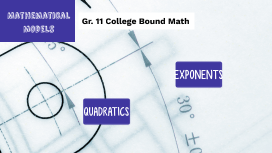Mathematical Models
Transcript: Gr. 11 College Bound Math Mathematical Models Standard Form QUADRATICS Vertex Form Factored Form Changing to This Form factored form y= 2(x+10)(x+2) standard form 2 y=2x + 24x +40 VERTEX FORM 2 y=2(x+ 6) - 32 How can we graph using standard form? Standard form is limited into identifying key features from the equation. Graphing Sub in x values and calculate corresponding y TO FIND POINTS TO GRAPH plot points and connect the dots! Example Graph Notebook pick x values to sub in (usually pick from -2 to 2 to get range of negatives and positives as well as 0! Let x =0 , y= 2(0)^2 - 5(0) +3 y= 0 + 0 + 3 y= 3 let x=1, ..... found x-intercept when subbed in 1, y ended up being 0 found y-intercept by subbing in 0 Key Features KEY FEATURES : y-intercept ideal is to find when y-values equal 0 (your zeros) play with x values y-intercept is when x=0. 2 y= a(0) + b(0) + c y= 0 + 0 + c y= c (0,c) the c , or constant value, at the end of the equation is the y-int. try to find 2 symmetrical points in the table ideal is to find your y-values change direction (from low values to high then back to low again) why? The vertex is found when the direction changes! Key Features KEY FEATURES : y-intercept ideal is to find when y-values equal 0 (your zeros) play with x values y-intercept is when x=0. 2 y= a(0) + b(0) + c y= 0 + 0 + c y= c (0,c) the c , or constant value, at the end of the equation is the y-int. try to find 2 symmetrical points in the table ideal is to find your y-values change direction (from low values to high then back to low again) why? The vertex is found when the direction changes! Changing to This Form y= 2(x+10)(x+2) factored form a=2 and x-intercepts are x= -10 and x= -2 h = -10 + (-2) / 2 h= -12/ 2 h= -6 VERTEX FORM let x= -6 in the equation and solve for y y= 2(-6 + 10)(-6 + 2) y= 2(4)(-4) y= 32 2 standard form y=2(x+ 6) - 32 2 2 y=2x + 24x +40 y=2(x+ 6) - 32 need to change to factored first then vertex form there is a way! it is called completing the square (different course material) TRICK: h= -b/2a sub in h for k TO FIND POINTS It is called vertex form because the vertex is in the equation! (h,k) is the vertex. TO GRAPH How can we graph using vertex form? Vertex form shows the transformations done to y=x^2. You can also use the step pattern to find points! Graphing Plot the vertex the and use the steps 1a,3a,5a,.. transform y=x by using the 5 key points and move them depending on a,h,k remember symmetry! Example ex. 1. Graph Notebook ex. 2 (x,y) (x-6, -4y-8) vertex: (h,k) so (-6,-8) transformations: reflection: yes, a is neg. vertical stretch: a=-4 so stretch by factor of 4 hor. translation: left 6 ver. tranlsation: down 8 move all x values left 6, multiply each y value by 4, make it negative, then down 8 Key Features KEY FEATURES : VERTEX Step Pattern: points move from vertex in a pattern over 1, up 1, over 1, up 3, over 1, up 5 if a value, then stretches/compresses each step to 1a,3a,5a,... h value is opposite sign you see! 2 (h,k) Direction of Opening if a>0 then opens up if a<0 then opens down can find the y-intercept by subbing in x=0 and solving for y in eqn: y=a(x-h) + k so always has a minus h 2 VERTEX FORM y=2(x+ 6) - 32 2 Changing to This Form a=2 find the zeros (y=0) 0=2(x+ 6) - 32 32=2(x+6) factored form 32/2=(x+6) standard form y= 2(x+10)(x+2) y=2x + 24x +40 2 2 sq root (16) =x+6 x= -6 + 4 or x=-6-4 x=-2 and x=-10 so factors are x+2 and x+10 divide each term by 2 to factor it out! 1. common factor 2. factor the trinomial __ + __ = 12 __ x __ = 20 y= 2(x+10)(x+2) y=2(x + 12x +20) y=2(x+10)(x+2) 20 1 20 2 10 3 4 5 How can we graph from factored form The easiest form to plot from is factored form. Graphing TO FIND POINTS find your zeros and plot them find the middle and plot the AOS and then calcuate the vertex to plot sub in 0 to find y-int then can use symmetry to find last point TO GRAPH Example Notebook Graph y= (x-4)(x+10) The solutions for when y=0 (x-intercepts) are x=4 and x=-10 Key Features KEY FEATURES : ZEROS y-interept can be calculated by subbing in x=0 and solving! factored form is multiplying terms together. Anything times 0 is 0 therefore if one bracket equals 0, then y=0 and makes it an x-intercept! (0,s) and (0,t) when y=a(x-s)(x-t) the AOS is found in the middle of 2 symmetrical points and the zeros are 2 points we can use to find it! h is the AOS value. sub in x=h into equation and solve for y =k, vertex at (h,k) h= s + t / 2 What are They? EXPONENTS equations where the exponent is the number changing! The Rules Exponent Rules The Graphs y=ab x The 3 forms -connected! Growth and Decay Title plot the points from the table and connect the dots! TABLE GRAPH EQUATION The variable is in the exponent spot! plug in x values (a few positive and a few negative ) and calculate the corresponding y values Title decay example The Equations Population Example Double Time Half-Life

















